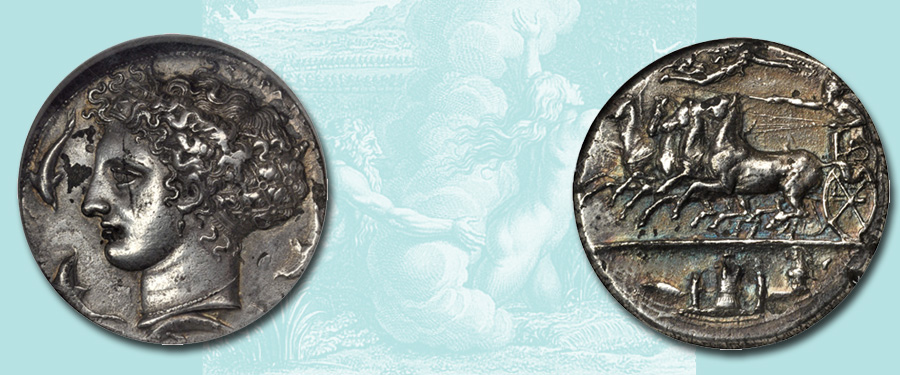
The inaugural preview for the upcoming January New York International Numismatic Convention Auction hosted by Stack’s Bowers Galleries is an exciting coin. The Decadrachms of Syracuse are widely considered to be some of the finest pieces of numismatic art in antiquity if not in the entire history of numismatics. When viewed in person it becomes difficult to argue, as the detail and style are marvelous. The Syracusan engravers Kimon and Euainetos led the period of high artistry in ancient numismatics, with this coin engraved by Kimon that is signed multiple times by him, attesting to his personal pride in these dies. The obverse and reverse designs for Syracuse most commonly depict a quadriga and the water nymph Arethusa. The quadriga design was used to honor the tyrants of Syracuse. These men were abundantly wealthy, and would frequently host chariot races and typically sponsored multiple teams within each race. These highly prestigious contests were great public relation events that boosted the reputation and esteem of the autocrat of the city. The nymph Arethusa was a maiden who became the desire of a river deity. He pursued her through the woods until she beseeched Artemis the moon goddess for aid. Through divine intervention Arethusa was transformed into an underground stream and directed to emerge as a fountain on the island of Ortygia, the historical center of the city of Syracuse.
This particular coin displays a quadriga being pulled by galloping horses driven left by a female charioteer leaning forward with a kentron in right hand and the reins in left hand. Nike (Greek goddess of Victory) appears flying above the horses heading right and attempting to crown the charioteer. A heavy exergual line appears, separating the quadriga and various military implements, including an aegis, greaves, helmet and spear. There is a signature on the exergual line though it is illegible due to die erosion. The reverse design bears the head of the above-mentioned water nymph Arethusa. She is depicted facing left wearing an ampyx (with artist’s signature “K” visible), necklace, earrings and hair net. The detail found in the curls of her hair is truly astonishing. The Greek ethnic for Syracuse appears only partially behind her head. Four dolphins appear around her head, with the lowermost dolphin (below Arethusa’s neck) signed as well. This example exhibits a fascinating die break along Arethusa’s forehead and extending over her eye, as well as a prominent die break amongst her hair. When you consider the exceptionally high relief of these dies (and their long period of use) it is no wonder these dies stressed and fractured. Some rough areas are present in the fields, though these appear stable. This is a wonderfully rendered example of this scarcely seen triple signature type. By applying his mark in triplicate, Kimon certainly proclaims his pride in this exceptional piece of numismatic art. Look for this and other world numismatic rarities in our upcoming January New York International Auction. For details please refer to the Events Calendar link at www.StacksBowers.com. Though our Stack’s Bowers January New York International Auction is no longer open for further consignments, we are now accepting consignments of world and ancient coins for our August 2016 ANA Auction as well as Chinese and other Asian coins and currency for our April 2016 Hong Kong Showcase Auction. Time is running short, so if you are interested in consigning your coins and paper currency (whether a whole collection or a single rarity) be sure to contact one of our consignment directors.





